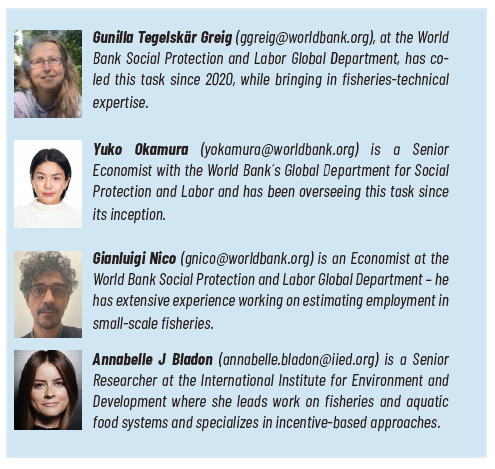Article II 3/2025 - BLUE SOCIAL PROTECTION: PROTECTING PEOPLE, FISH AND FOOD
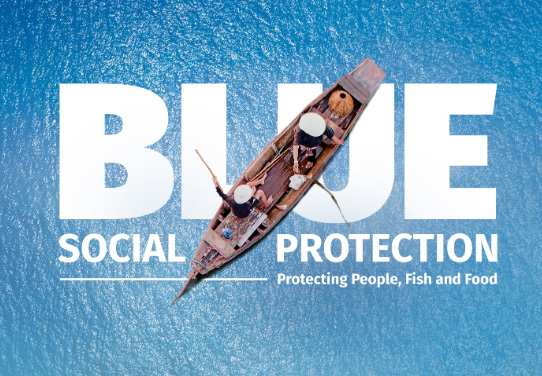
Efforts to manage fisheries are often hindered by a focus on short-term production and profit at the expense of environmental sustainability and social equity. Most approaches have also tended to concentrate solely on the fisheries sector, without considering the broader benefits that sustainable fisheries provide and the societal risks associated with fish-stock decline. In addition, ministries responsible for fisheries and for social protection and jobs (SPJ) have different institutional mandates and few incentives to coordinate. Given the generally small size of the fisheries sector in terms of gross domestic product (GDP), this shortterm, single-sector approach undercuts the justification and motivation to strengthen investments in fisheries management. Fisheries workers are thus typically expected to shoulder the short- to medium-term costs that fisheries management measures impose. These costs, such as lost income, often undermine the effectiveness of new or existing measures.
SPJ could play an instrumental role in facilitating fisheries policy reforms and supporting associated management measures, strengthening the outcomes of management interventions and promoting sustainability and productivity across this and related sectors. However, evidence on the impact of adapting SPJ to the fisheries sector is still limited, and in a context of weak fisheries management and narrow sectoral integration, interventions can also have undesirable outcomes.
This article outlines the World Bank team’s endeavors in the intersectoral agenda, Blue Social Protection: Protecting People, Fish and Food.
Overview: Blue Social Protection
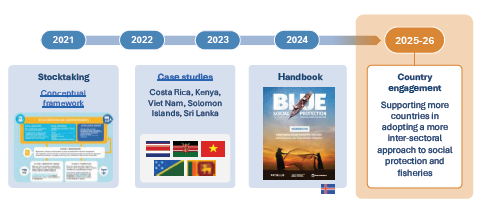
Country engagement
The Country Notes were prepared by country teams that are closely supporting government counterparts, particularly ministries in charge of fisheries, social affairs, and labor. The World Bank team is currently undertaking a mapping exercise to identify additional countries that are exploring or have otherwise taken an interest in this intersectoral agenda.
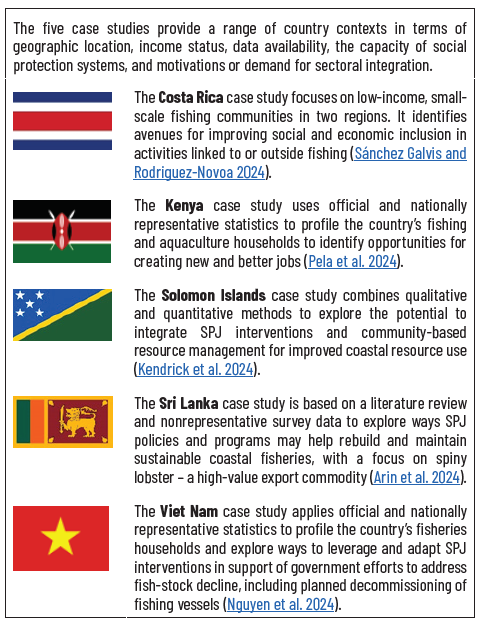
The Blue Social Protection handbook
The handbook is sufficiently comprehensive and flexible to accommodate a range of contexts, size and scale considerations, interests, and objectives. It also aims to support countries in enhancing SPJ systems to be more inclusive and adaptive to climate-related and other shocks by responding to the needs of specific sectors and groups.
While the focus of the handbook is on fisheries management, it also contains information and lessons of wider relevance for addressing climate risks, disasters, and biodiversity loss and deploying SPJ to support sustainability in other sectors. Practitioners could adapt the guidance to enable and incentivize the participation of coastal or other communities in biodiversity conservation and to support efforts to enhance SPJ responsiveness to risks in other sectors, such as agriculture and forestry.
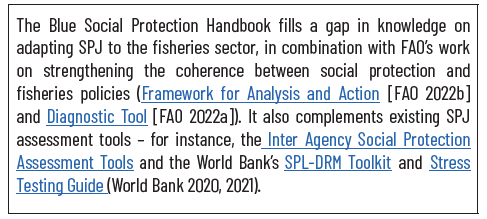
Structure and contents of the handbook
Problem statement: rationale and challenges
Fisheries face a range of risks arising from interlinked socioeconomic and ecological processes. Human activities, both within and beyond fisheries, increasingly drive changes in ecological systems that, in turn, amplify socioeconomic risks within fisheries, creating complex socialecological feedbacks that further exacerbate the vulnerability of people who depend on them.
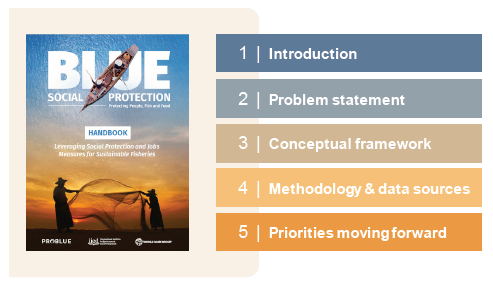
At an institutional level, differences in mandates and objectives between the fisheries and the SPJ sectors limit the incentives for coordination. The ministries responsible for fisheries tend to focus on production and related environmental issues and usually deal less with broader poverty and vulnerability issues, while the ministries responsible for SPJ tend to focus on poor households, rather than specific economic sectors such as fisheries. As a result, SPJ and fisheries policies and associated strategies tend to be disconnected and incoherent, leading to ineficient and often ineffective programs.
The social-ecological risks faced by the fisheries sector, along with policy and institutional challenges, can be illustrated as follows:
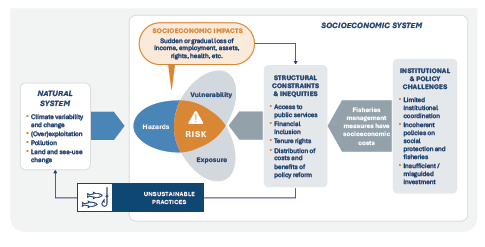
Three main opportunities have been identified for SPJ to facilitate and enable more productive and sustainable fisheries, as follows:
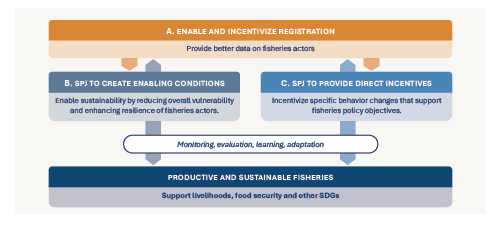
- First, SPJ programs, such as conditional transfers, public works, and temporary unemployment benefits, can offset the short- (but potentially recurring) and medium-term socioeconomic costs of management measures designed to reduce fishing effort, such as seasonal closures.
- Second, where longer-term interventions are required to reduce the total number of fisheries workers in a specific fishery value chain or area, SPJ programs can facilitate livelihood diversification and support transition away from those activities. Examples include active labor market programs and economic inclusion approaches that combine upskilling or reskilling with grants and complementary financial services.
Furthermore, SPJ benefits and services can help enable and incentivize fisheries actors to register themselves, their assets, and their activities (point A in the figure). If supported by targeted outreach, this can provide data that are fundamental to fisheries management and inform SPJ design and support implementation.
Methodology and data sources
To design and adapt SPJ interventions to promote sustainable and productive fisheries, it is necessary to collect and analyze data relevant to the fishery or geographical area of interest. This section of the handbook provides practical guidance on socioeconomic profiling and assessing the social-ecological risks in fisheries, in addition to conducting rapid assessments across SPJ and fisheries on institutional arrangements and policies, programs and implementation systems, and financial context.
Based on guiding questions included in each subsection, the handbook outlines resources and data that may be considered as a starting point, along with additional methods, resources and tools for when these are not available.
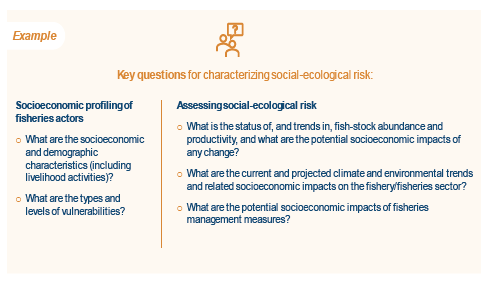
Based on the experience from country case studies and the development of the handbook, the following six key priority actions have been identified that governments and development partners can take to maximize the use and potential of SPJ for sustainable fisheries:
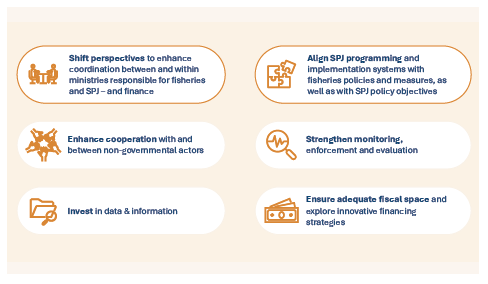
- Enhance intra- and interministerial coordination to increase coherence between SPJ and fisheries policies. This can include joint programming and performance-based budgets, common monitoring and evaluation frameworks, and collaborative impact assessments before introducing new fisheries management measures.
- Improve cooperation with and among nongovernmental actors to support SPJ implementation and build on existing informal SPJ functions. These actors might include fisheries organizations, community-based organizations, and nongovernmental organizations, which can play an instrumental role in supporting outreach, SPJ provision, and monitoring, especially in remote areas.
- Increase the quantity and quality of socially inclusive and gendersensitive socioeconomic data on fisheries. This can be accomplished by adapting existing data collection mechanisms, such as household survey questionnaires, to include basic information on fisheries households and by expanding the sample to ensure it is statistically representative.
- Align SPJ programming with fisheries policy objectives and associated management measures. This includes adapting eligibility criteria and target populations for SPJ interventions and ensuring that benefit and service packages are appropriate relative to the costs fisheries workers and communities incur because of fisheries management measures.
- Strengthen monitoring, enforcement, and evaluation to ensure that SPJ interventions are effective and eficient. This includes addressing limitations in fisheries monitoring and enforcement through collaborative and community-based approaches and evaluating the impact on human vulnerability and sustainable fisheries.
- Ensure adequate fiscal space and explore innovative financing strategies for SPJ to support sustainable fisheries. This includes reforming and repurposing harmful fisheries subsidies, exploring more innovative means of financing incentives for sustainable fisheries, and accessing international climate and nature finance.
Conclusion
Links to resources
- Blue Social Protection Handbook (Bladon et al. 2025)
- Country case studies: Overview note and five countries (Arin et al. 2024; Kendrick et al. 2024; Nguyen et al. 2024; Okamura et al. 2024; Pela et al. 2024; Sánchez Galvis and Rodriguez-Novoa 2024)
- Conceptual Framework note (Bladon, Tegelskär Greig, and Okamura 2022), with Infographic (Bladon 2022)
- Blog (Bladon and Okamura 2022)
- Webinars: February 2025, November 2024 (World Bank and IIED 2024, 2025)
References
- Arin, Tien, Shalika Subasinghe, Annabelle J. Bladon, and Tiloka de Silva. 2024. “Integrating Social Protection and Economic Inclusion with Management of Sri Lanka’s Coastal Fisheries.” Blue Social Protection Series: Protecting People, Fish and Food, Social Protection and Jobs Policy and Technical Note 40 (June), World Bank, Washington, DC.
- Arin, Tien, Shalika Subasinghe, Annabelle J. Bladon, and Tiloka de Silva. 2024. “Integrating Social Protection and Economic Inclusion with Management of Sri Lanka’s Coastal Fisheries.” Blue Social Protection Series: Protecting People, Fish and Food, Social Protection and Jobs Policy and Technical Note 40 (June), World Bank, Washington, DC.Bladon, Annabelle J. 2022. “Connecting Social Protection and Fisheries Management For Sustainability.” June, International Institute for Environment and Development, London.
- Bladon, Annabelle J., Gunilla Tegelskär Greig, and Yuko Okamura. 2022. “Connecting Social Protection and Fisheries Management for Sustainability: A Conceptual Framework.” Social Protection and Jobs Policy and Technical Note 25 (May), World Bank, Washington, DC.
- Bladon, Annabelle J., Gunilla Tegelskär Greig, Yuko Okamura and Gianluigi Nico. 2025. “Blue Social Protection Handbook: Leveraging Social Protection and Jobs for Sustainable Fisheries.” Blue Social Protection Series: Protecting People, Fish and Food, World Bank, Washington, DC.
- Bladon, Annabelle J., and Yuko Okamura. 2022. “How Social Protection Can Support People and Sustain Fisheries.” IIED Insight (blog), June 6, 2022. https://www.iied.org/how-social-protection-can-support- people-sustain-fisheries.
- FAO (Food and Agriculture Organization of the United Nations). 2022a. “Strengthening Coherence between Social Protection and Fisheries Policies: Diagnostic Tool.” FAO Fisheries and Aquaculture Technical Paper 671/2, FAO, Rome.
- FAO (Food and Agriculture Organization of the United Nations). 2022b. “Strengthening Coherence between Social Protection and Fisheries Policies: Framework for Analysis and Action.” FAO Fisheries and Aquaculture Technical Paper 671/1, FAO, Rome.
- FAO (Food and Agriculture Organization of the United Nations), Duke University, and WorldFish. 2023. Illuminating Hidden Harvests: The Contributions of Small-Scale Fisheries to Sustainable Development. Rome: FAO.doi.org/10.4060/cc4576en.
- Kendrick, Anita, Vincenzo Vinci, Xavier F. P. Vincent, Fiona Howell, and Son Hoai Nguyen. 2024. “Opportunities for Linking Fisheries Management and Social Protection in Solomon Islands.” With contributions by International Food Policy Research Institute and WorldFish. Blue Social Protection Series: Protecting People, Fish and Food, Social Protection and Jobs Policy and Technical Note 39 (June), World Bank, Washington, DC.
- Nguyen, Nga Thi, Gianluigi Nico, Thanh Hai Nguyen, Annabelle J. Bladon, and Anna Ducros. 2024. “Connecting Social Protection, Labor Market Interventions, and Fisheries Management in Viet Nam.” Blue Social Protection Series: Protecting People, Fish and Food, Social Protection and Jobs Policy and Technical Note 41 (June), World Bank, Washington, DC.
- Okamura, Yuko, Annabelle J. Bladon, Gunilla Tegelskär Greig, and Gianluigi Nico. 2024. “Integrating Social Protection with Fisheries Management for Sustainability: Overview of Country Case Studies.” Blue Social Protection Series: Protecting People, Fish and Food, Social Protection and Jobs Policy and Technical Note 36 (June), World Bank, Washington, DC.
- Pela, Kevwe, Samantha De Martino, Federica Ricaldi, and David Japp. 2024. “Supporting Sustainability in Kenya’s Fisheries through Social Protection and Labor Market Interventions.” Blue Social Protection Series: Protecting People, Fish and Food, Social Protection and Jobs Policy and Technical Note 38 (June), World Bank, Washington, DC.
- Porras, Ina. 2019. “No Hidden Catch: Mainstreaming Values of Small- Scale Fisheries in National Accounts.” February, International Institute for Environment and Development, London.
- Sánchez Galvis, Martha, and Luz Stella Rodriguez-Novoa. 2024. “Exploring Alternatives for the Economic Inclusion of Low-Income, Artisanal Fisher Communities in Costa Rica: Case Study of Artisanal Fishing and Mollusk Gathering Communities in Puerto Cortés and Golfo Dulce.” Blue Social Protection Series: Protecting People, Fish and Food, Social Protection and Jobs Policy and Technical Note 37 (June), World Bank, Washington, DC.
- Short, Rebecca E., Stefan Gelcich, David C. Little, Fiorenza Micheli, Edward H. Allison, Xavier Basurto, Ben Belton et al. 2021. “Harnessing the Diversity of Small-Scale Actors is Key to the Future of Aquatic Food Systems.” Nature Food 2 (9): 733–41.
- World Bank. 2020. SPL-DRM Toolkit: Social Protection and Labor, Disaster Risk Management. Washington, DC: World Bank.
- World Bank. 2021. “Stress Testing Social Protection: A Rapid Appraisal of the Adaptability of Social Protection Systems and Their Readiness to Scale Up.” Guide for Practitioners, Version 1, World Bank, Washington, DC.
- World Bank and IIED (International Institute for Environment and Development). 2024. “Integrating Social Protection with Fisheries Management for Sustainability.” Webinar, November 2024. https://cdnapisec.kaltura.com/index.php/extwidget/preview/partner_ id/1930181/uiconf_id/29317392/entry_id/1_7g3rtnm2/embed/ dynamic.
- World Bank and IIED (International Institute for Environment and Development). 2025. “Handbook for Blue Social Protection: Practical Knowledge to leverage Social Protection and Jobs Interventions.” Webinar, February 2025. https://cdnapisec.kaltura.com/index.php/ extwidget/preview/partner_id/1930181/uiconf_id/29317392/entry_ id/1_p8f7vjmv/embed/dynamic.
